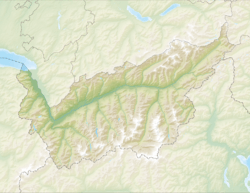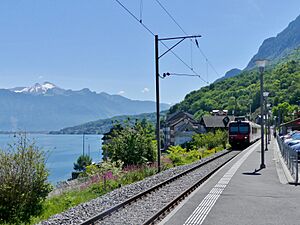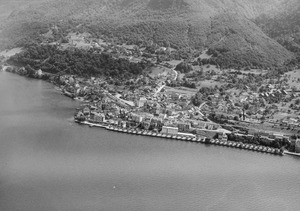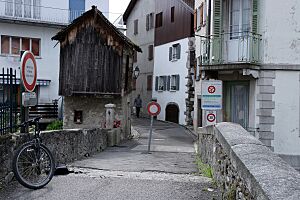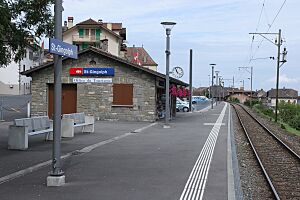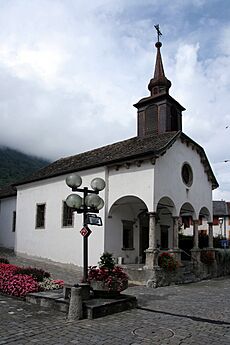Saint-Gingolph, Switzerland facts for kids
Quick facts for kids
Saint-Gingolph
|
||
|---|---|---|
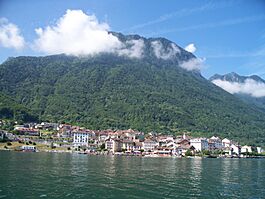
A view of Saint-Gingolph from Lake Geneva
|
||
|
||
| Country | Switzerland | |
| Canton | Valais | |
| District | Monthey | |
| Area | ||
| • Total | 14.45 km2 (5.58 sq mi) | |
| Elevation | 386 m (1,266 ft) | |
| Population
(Dec 2020 )
|
||
| • Total | 964 | |
| • Density | 66.71/km2 (172.79/sq mi) | |
| Postal code |
1898
|
|
| Surrounded by | Corseaux (VD), Novel (FR-74), Port-Valais, Saint-Gingolph (FR-74), Vevey (VD), Vouvry | |
Saint-Gingolph is a small town, also called a municipality, in Switzerland. It is located in the canton of Valais, within the Monthey district. In 2018, about 981 people lived there.
This town is special because it sits right on the France–Switzerland border. The border is formed by the Morge river. One part of the town is in Switzerland, and the other part, on the French side, is called Saint-Gingolph, Haute-Savoie.
Contents
History of Saint-Gingolph
Saint-Gingolph is a very old place. The first time it was ever written about was in the year 1153. Back then, it was known by the name Sanctus Gengulfus.
For a long time, before 1569, the Swiss part of Saint-Gingolph, a small village called Le Freney, and the French part of Saint-Gingolph were all one single town.
Geography and Landscape
Saint-Gingolph covers an area of about 14.4 square kilometers (about 5.6 square miles). A big part of this land is covered by forests, making up about 61% of the area.
About 11.2% of the land is used for farming. This includes pastures where animals graze. A small part, about 4.6%, has buildings and roads. The rest of the land, about 22.7%, is not used for farming or buildings. This includes rocky areas and wild plants.
All the water in the municipality comes from lakes.
What is the Coat of Arms?
A coat of arms is like a special symbol or emblem for a town or family. It often tells a story about the place. The coat of arms for Saint-Gingolph is described as: "Per bend serrated Argent and Gules overall an Otter rampant Sable langued Gules and armed of the first in chief sinister a Mullet of Five of the second."
This means it has a zig-zag line dividing it into two parts. One part is silver (Argent), and the other is red (Gules). On top of this, there is a black otter standing on its hind legs. It has a red tongue and silver claws. In the top left corner, there is a red five-pointed star.
Population and People
As of 2022, Saint-Gingolph has a population of 981 people. Over the past ten years (from 2000 to 2010), the number of people living here grew by about 23.3%. Most of this growth was because new people moved into the town.
Most people in Saint-Gingolph speak French as their main language. About 86.9% of the population spoke French in 2000. Other languages spoken include German and Serbo-Croatian.
In 2008, the population was almost evenly split between males and females. About 49.6% were male, and 50.4% were female. Many people living in Saint-Gingolph were born there or in the same canton. About 16.8% of the people were born outside of Switzerland.
In 2000, about 22.5% of the population were children and teenagers (under 19 years old). Adults (20-64 years old) made up 56.1%, and seniors (over 64 years old) were 21.3% of the population.
There were 311 households in the town in 2000, with about 2.1 people living in each home on average.
Important Places
The entire area of Saint-Gingolph is recognized as an Inventory of Swiss Heritage Sites. This means it has special historical or cultural importance and is protected.
Jobs and Economy
In 2010, the unemployment rate in Saint-Gingolph was 5.3%. This means that about 5.3% of people who wanted to work could not find a job.
Most jobs in Saint-Gingolph are in the tertiary sector. This sector includes jobs like working in shops, hotels, restaurants, or providing services. In 2008, there were 109 people working in this sector.
There were also jobs in the secondary sector, which includes manufacturing and construction. About 27 people worked in this area. A very small number of people worked in the primary economic sector, which is farming.
Many people who live in Saint-Gingolph travel to other towns for work. About 32.4% of the people who come to work in Saint-Gingolph are from outside Switzerland. Most people (70.5%) use a private car to get to work, while 8.1% use public transportation like trains or buses.
Religion in Saint-Gingolph
According to the 2000 census, most people in Saint-Gingolph are Roman Catholic, making up about 61.6% of the population. About 11.0% belonged to the Swiss Reformed Church.
A smaller number of people belonged to other Christian churches, or were Muslim or Buddhist. About 8.93% of the population said they did not belong to any church.
Schools and Learning
Many people in Saint-Gingolph have a good education. About 32.5% of the population have finished upper secondary education, which is like high school. About 12.4% have gone on to higher education, like university or a specialized college.
In 2000, most students from Saint-Gingolph went to schools outside the municipality.
The town also has a public library called the Bibliothèque communale. In 2008, this library had over 5,540 books and other items. It was open for about 8 hours each week.
See also
 In Spanish: Saint-Gingolph para niños
In Spanish: Saint-Gingolph para niños




